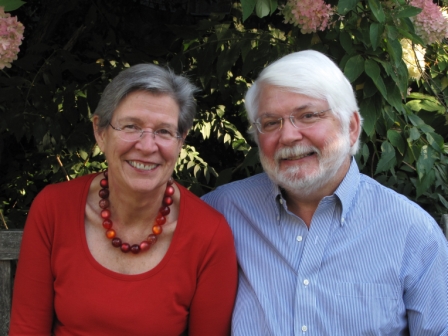Dr. Sheila Blair is a professor of Art History at Boston College. She received her Ph.D. in Fine Arts and Middle Eastern Studies at Harvard University. Her research is equally broad: she has written or co-written 17 books, including several international award winners, and more than 200 articles in journals, encyclopedias, colloquia, and festschriften. Several of her books were written with her husband and co-holder of the Calderwood Chair, Jonathan Bloom, with whom she served as artistic consultant to the three-hour documentary Islam: Empire of Faith, shown nationally on PBS. Some of her remarkable works are:
Text and Image in Medieval Persian Art (Edinburgh University Press, 2013)
Islamic Calligraphy (Edinburgh University Press, 2006)
Islamic Inscriptions (Edinburgh University Press, 1998)
A Compendium of Chronicles: Rashid al-Din's Illustrated History of the World, (Oxford University Press, 1995)
The Monumental Inscriptions from Early Islamic Iran and Transoxiana (E. J. Brill, 1992)
The Ilkhanid Shrine Complex at Natanz, Iran, Harvard Middle East Papers, Classical Series no. 1 (Cambridge, MA: Center for Middle Eastern Studies, Harvard University, 1986).
Professor Blair teaches about all aspects of Islamic art from the seventh century to modern times. She offers surveys on Islamic art, architecture, and urbanism, as well as research seminars on the Silk Road, the Islamic book, and the arts of the object.
Dear Prof. Blair, it is my great pleasure to have an interview with you regarding Iranian medieval art and architecture. One of the controversial issues in Iranian studies is which period can be specified as medieval times. Based on art history which phase of history do you regard as the medieval history of Iran?
I would say that for me as an art historian medieval history runs from post-Sassanian up to the modern period. So we are talking about chronological centuries, sometime between the eighth and the tenth centuries depending on where you are in Iran up until the pre-Modern period, which would be around 1500, so up to the rise of the Safavids.
Based on the characteristics of Iranian art and architecture to what phases do you divide the medieval history of Iran?
Pre-Mongol and Post-Mongol phases because the Mongol conquests were important for art not just in terms of conquests but more so in terms of the exchange of goods and ideas.
You have done many remarkable studies on Islamic Art and Architecture including Iranian art. What are the main characteristics of Iranian art and architecture that distinguish them from those of other Islamic countries?
I would say that first and foremost is quality. Iranian art is excellent, it is first-rate, it is extremely creative, it is made from very fine materials and it is often just better in terms of quality; not necessarily in terms of interest or historical authenticity but in terms of quality; it is often better than the arts produced nearby.
Is this also true for architecture?
Architecture as well; is just extraordinarily inventive the methods that builders created to support the domes, the techniques they invented to decorate with the tiles; the constant creativity of architects and artists.
You have done very impressive research on inscriptions namely "the Monumental Inscriptions from Early Islamic Iran and Transoxiana". Doing this kind of research is so challenging. I mean you had to visit many monuments and read their inscriptions whose many parts were missing throughout time or because of clumsy restoration. Can you explain a little about the different kinds of problems you had in doing this precious research and how you were able to solve them?
I think the biggest difficulty is having to fill in the gaps because we have so little that survives of what must have been much more prolific. There must have been many more inscriptions and we have only a few. So it’s very different than places like the Mamluks in Egypt or the Ottoman in Turkey. There we have thousands of inscriptions and you really know what they say because you have many. The Iranian material is so piecemeal.
So how could you read these inscriptions? For instance, in Chehel Dokhtar, some parts are missing or unreadable because of clumsy inscriptions. So how did you deal with this problem?
For many inscriptions, the only way is to read the inscription is to imagine what they are going to say in advance. So for instance, if you know that many inscriptions begin with Besmallah; so you can read it very easily. Then you have to figure out the letters in other inscriptions. And you know if it begins with Besmellah, it probably ends with a date. So in a circular inscription, you look at the text right before the Besmellah to see if you can find the date. It is often easier to do with the photographs because you can play with the contrast on your computer or on your copy machine, and you can try to highlight or blow up certain parts of it, so some of it can be much bigger or much smaller.
Your study on Islamic Calligraphy is so fascinating. What are the peculiarities of Iranian calligraphy?
Writing in Persian rather than Arabic means that you have a different group of letters and have a different grammar. So the scholar named Vlad Atanasiu figured out that Nasta’liq script really works only with Persian because many words end with final ی or final ین with a big ن, letters you can write with long sloping tails. You don’t have that in Arabic so we have different kinds of calligraphy to write Arabic than to write Persian. I think that Quran manuscripts in Nasta’liq don’t look as good as poetry in Nasta’liq where all words are the rhyme and so there are so many sloping movements that you cross the page. So certain styles of Calligraphy are better for writing Persian.
Rivers of Paradise: Water in Islamic Art and Architecture is unique and full of innovations. What stimulated you and Prof. Bloom to write this book?
We didn’t actually write it; we just edited it. It contains the papers of a conference that we run every two years. We try to pick major topics and then get different scholars to approach these themes from different perspectives. Water was our first theme, and we had people speak about water in the Quran, water in poetry, how to conserve water, how to use water in gardens, how it was shown in miniatures painting, etc. We only put these papers together and edit them in this volume. We’ve edited four of these volumes now: one on color, on objects of Islamic art, and one on "light" that is going to be published this Fall.
So you had four conferences on four different subjects. Will you have upcoming conferences in the future?
We are going to have the fifth conference this fall in Doha. It’s going to be on writing in Islamic art and culture. So we are going to have papers on writing in the Quran, writing Persian poetry, the writing of history, manuscripts, the materials on which you write the manuscripts, all kinds of things that have to do with the word in Islamic art and culture. And for this one I’m giving the main opening lecture, “Inscriptions and Words”, so I have to do a lot of work.
Nowadays the architecture of Islamic societies is deeply affected by modern architectural features. Do you regard it as a threatening problem for Islamic architecture? Does the architecture of Islamic society have any impact on modern architecture?
I don’t think it is a threat, since I believe that architecture is always a balance between the environment and the requirements for a particular building. So for mosques, you have certain religious needs: space for praying, you need space for washing, and so forth. You can meet those needs with different materials, different techniques, and different kinds of decorations. I think our challenge is to create inventive ones. So it’s kind of silly to make old style-brick mosques in modern Iran. They were perfect for the 12th century but they are not right for today.
Does Islamic architecture impact modern constructions?
Regarding western architecture, we have a different climate here. So it will be a kind of silly where I live in the middle of New Hampshire and it often rains and snows in the winter to have a house with an open courtyard.
But most of the buildings made in Iran these days are just apartments that are based on western architecture.
I think people live in apartments because we can have to pack more people into the same land and space but I’m not sure that you need the space to always reflect western modes. If you are going to sit on the floor, you don’t need to have a living room and a dining room which are very western rooms because we sit at tables and on chairs so we need a dining table in our dining room and a sofa in our living room. If you can sit on your beautiful carpets, so you can live in the same room.
But nowadays people prefer to sit at tables and chairs.
Right, but that’s a western model of life.
Can you explain a little about your upcoming studies on Iranian Art and architecture?
I’m working on the Mongol period. So, I’m now writing several papers on Mongol art. I’m writing an article on the architecture under the Il-Khanids, and the Timurids, the two Mongol dynasties ruling in Iran because I think that much of the finest architecture of medieval Iran was produced in the Mongol era. One of the characteristics that came into prominence in the Mongol period was an interest in size. The Mongols liked big structures. It seems that they were interested in big not just because of its size but also because they regarded big as better. They also had an abiding interest in color. During that period there is an explosion of color on the exterior of the buildings. It began earlier but in the Mongol period it exploded and so we had wonderful tiles covering exteriors.
How was Islamic art influenced by Pre-Islamic art?
The use of brick certainly continued from pre-Islamic times to the Islamic period in Iran. So did interest in using figures and pictures of people in art and it’s something specific to Iran, not found in other art of the Islamic world. For instance, in Saudi Arabia or in northern Africa they were not as interested in illustrated manuscripts, but in Iran, you have wonderful copies of Shahnama and all other sorts of poetic books. We also have ceramics covered with decoration, with pictures of people, animals, and things and they are wonderful.
To wrap up, please let us know if you have any other points about the characteristics of Iranian art and architecture?
I think more people need to know about Iranian art, which they don’t. It’s very sad because it’s a very interesting and high-quality tradition. It is very interesting because it is between China and Europe. So it has elements from both and sometimes its elements are exported in both directions. It’s exciting to study because it’s so interesting.
There is a huge gap between Iran and other parts of the world. We don’t know what you are doing because we can’t get your books and journals here and I think it’s true about you too. You don’t know what we are doing here.
Thank you so much for your consideration and time.
You’re welcome.
Interviewed by Maryam Kamali

